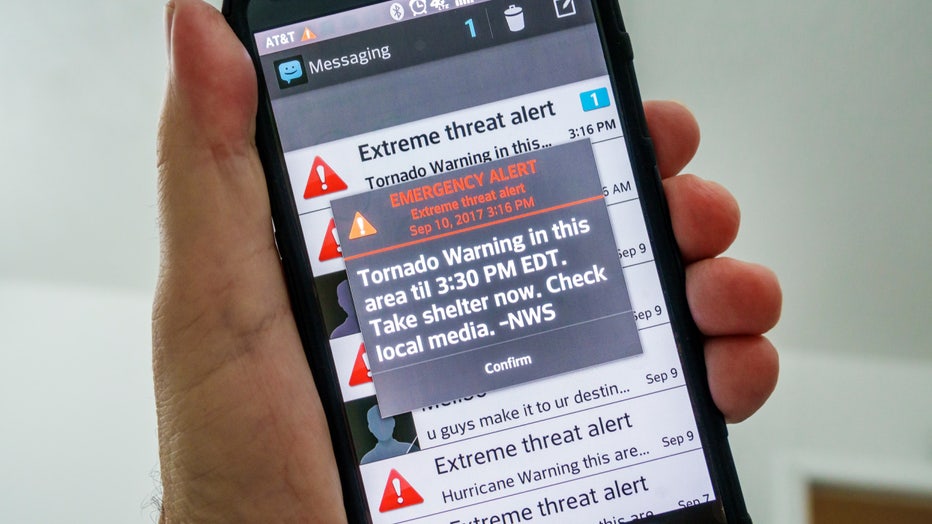What does tornado warning mean? What to know about watches, signs of tornado in Florida
Stream FOX 35 News:
FLORIDA - Sometimes in Florida, the threat of severe weather brings the possibility of tornadoes in the area. Here's what you need to know to stay safe:
What does tornado warning mean?
When a tornado warning is issued, that means a tornado is imminent or about to happen, according to the National Weather Service. At this time, you should seek safe shelter immediately and wait for the all-clear from local officials.
What does tornado watch mean?
A tornado watch is issued when tornadoes and severe thunderstorms are possible in and near the watch area, the NWS said. This does not mean they will happen, but only means that they are possible.
The NWS defines a severe thunderstorm with winds of 58 mph or higher and/or producing hail 1-inch in diameter or larger.

Signs of a tornado
Here's a few tornado danger signs, according to the National Weather Service:
- Dark, often greenish clouds/sky
- Wall Cloud - an isolated lowering of the base of the thunderstorm
- Debris cloud
- Large hail
- Funnel Cloud
- Roaring Noise
Tornado safety tips
Here's a list of tornado safety tips from the National Weather Service:
Preparation
- Know the county you live in. The NWS issues Tornado Warnings that are polygon-based, and may include an entire county, or more likely portions of neighboring counties.
- Stay abreast of the latest forecast via NOAA Weather Radio, commercial radio or TV. Keep a watchful eye on the sky, and consider postponing outdoor activities.
- Know your communities warning system. Communities have different ways of warning residents about tornadoes, with many having sirens intended for only outdoor warning purposes.
- Pick a safe room in your home where household members and pets may gather during a tornado. This should be a basement, storm cellar, or an interior room on the lowest floor with no windows.
- Practice periodic tornado drills so that everyone knows what to do if a tornado is approaching.
- Prepare for high winds by removing diseased and damaged limbs from trees.
- Move or secure lawn furniture, trash cans, hanging plants or anything else that can be picked up by the wind and become a projectile.
During a tornado
- Safest place to be is an underground shelter, basement or safe room. Cover your head with your arms, a mattress, or heavy blanket.
- If no underground shelter is available, a small, windowless interior room or hallway on the lowest level of a sturdy building is the safest alternative.
- Stay away from windows!
- Get out of large auditoriums or large warehouses.
- Mobile homes are not safe during tornadoes or severe winds (nearly 40 percent of all tornado-related deaths come from residents of mobile homes). Do not seek shelter in a hallway or bathroom of a mobile home. If you have access to a sturdy shelter or a vehicle, abandon your mobile home immediately.
- If you are caught outdoors, seek shelter in a basement, shelter, or sturdy building. If you cannot quickly walk to a shelter: Immediately get into a vehicle, buckle your seat belt and try to drive to the closest sturdy shelter. If flying debris occurs while you are driving, pull over and park. Now you have the following options as a last resort: Stay in the car with the seat belt on. Put your head down below the windows, covering with your hands or a blanket if possible. If you can safely get noticeably lower than the level of the roadway, exit your car and lie in that area, covering your head with your hands.
- Immediately get into a vehicle, buckle your seat belt and try to drive to the closest sturdy shelter.
- If flying debris occurs while you are driving, pull over and park. Now you have the following options as a last resort: Stay in the car with the seat belt on. Put your head down below the windows, covering with your hands or a blanket if possible. If you can safely get noticeably lower than the level of the roadway, exit your car and lie in that area, covering your head with your hands.
- Stay in the car with the seat belt on. Put your head down below the windows, covering with your hands or a blanket if possible.
- If you can safely get noticeably lower than the level of the roadway, exit your car and lie in that area, covering your head with your hands.
- Never drive directly toward a tornado or in the vicinity of a tornado. Any tornado can change direction or speed quickly and put you at risk. Drive at right angles away from the tornado or get out of your vehicle and seek shelter immediately.
- Highway over-passes are not necessarily the safest outdoor place to be. People have been killed while hiding underneath an over-pass as a tornado moved overhead. Instead, seek a sturdy shelter or lie flat on the ground and cover your head with your arms.
After a tornado
- Continue listening to local news or a NOAA Weather Radio for updated information.
- Stay out of damaged buildings.
- Watch out for fallen power lines or broken gas lines and report them to the utility company immediately.
- Take pictures of damage, both of the building and its contents for insurance claims.
- Clean up spilled medications, bleaches, gasoline and other flammable liquids that could become a fire hazard.
DOWNLOAD THE FOX 35 WEATHER APP

